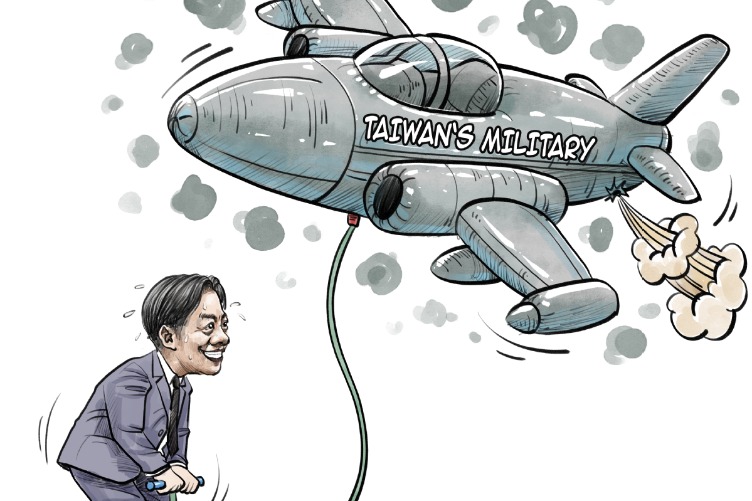Weaving rugs to save tigers

China Reform and Opening – Forty Years in Perspective
Weaving rugs to save tigers
Editor's note: Laurence Brahm, first came to China as a fresh university exchange student from the US in 1981 and he has spent much of the past three and a half decades living and working in the country. He has been a lawyer, a writer, and now he is Founding Director of Himalayan Consensus and a Senior International Fellow at the Center for China and Globalization.
He has captured his own story and the nation's journey in China Reform and Opening – Forty Years in Perspective. China Daily is running a series of articles every Thursday starting from May 24 that reveal the changes that have taken place in the country in the past four decades. Starting this month, China Daily will run two articles from this series each week – on Tuesday and Thursday. Keep track of the story by following us.

2006, Lhasa: One afternoon Gusan accompanied me to the market. It was a large two-story building on the circumambulation route called the Barkor. Inside the market building there were many wholesale and retail dealers, selling everything from turquoise to rugs. We went up to the second floor and looked at the rugs.
I found a tiger rug.
The pattern matched traditional motifs I’d seen in books on the subject. “This is the one we want to buy,” I exclaimed, and began bargaining. She gently grabbed my sleeve and pulled me aside, whispering in my ear, “Why do you want to buy that? It is not made by Tibetans, but imported.”
I was stunned. “But it is a traditional rug, right?”
“No,” she whispered even more softly. “It is a traditional design. The rug is made in commercial factories. It is not a traditional weave, and not a hand-made product by local people.” She nodded toward the salespeople. “They will not sell traditional Tibetan products. All of these products sold by these dealers are coming from industrial cities, not from nomadic regions. They are all machine-made, mass-produced. Look,” she said leading me back over to the rug, touching it with an open palm that was already well worn from years of work weaving rugs as a child. “This is all synthetic,” she sighed. “It is not real wool. The dye is chemical, not natural pigment. The tourists are all buying industrially made rugs, when Tibetan weavers have no work and are losing their traditional artisan skills.”
I was taken back by this instant lesson in local economics and pondered it for a moment, staring at the commercial dealers pushing with peppery voices the wonderful characteristics of their rugs.
“Let’s go,” I said. We went back to Shambhala House.
I found Pembala on a sunny terrace sipping yak butter tea. He asked where I had gone. “I went to buy a Tibetan rug only to find that none were made in Tibetan regions locally”. We put our heads together over our afternoon tea and brainstormed how to revive traditional rug weaving.
Pembala explained that his wife was once a rug weaver who’d won awards for her skill. But the average salary of a rug weaver was only about RMB 300 (less than $50) a month. She actually made more money selling cigarettes at Tsongksikhang market than weaving rugs. In any case, the local rug factory had been forced out of business by growing inflation, flat wages, and a rapidly dwindling traditional rug market due to mass industrial manufacturing. How could it compete with the machine-made synthetic rugs with their cheap chemical dyes?
We did our own market survey. After visiting all of the shops in Lhasa’s main tourist sites, we estimated that 90 percent of Tibetan-style rugs for sale came from other industrial cities and were not made by ethnic Tibetans at all. Of those “real” Tibetan rugs on the market, most were imported from Nepal. Locally Tibetan-made rugs were actually quite rare.
So we embarked on a project to revive traditional Tibetan rug making, using natural dyes, traditional weaving techniques and wool collected from nomadic communities. We recruited village and nomadic women who knew how to weave rugs and wanted to pass the tradition to the next generation. We then began selecting designs for the rugs that would be made in our rug cooperative. The idea struck to use traditional tiger patterns as a rug design.
In the old days tiger skins symbolized protector spirits. They were used to wrap sutra boxes, as meditation mats or hung on temple doors as a wrathful warning to demons. Tibetans prized such skins, respected and cared for them. Using tiger skins sparingly, Tibetans maintained a cycle of balance and respect with their environment. Such skins were passed down through generations and carefully guarded.
The Himalayan mountain range and foothills was the tiger’s natural habitat until the 19th Century. The British Raj organized expeditions for tiger trophies and bounty hunting. This led to wholesale decimation of the Himalayan tiger, disrupting entire cycles of environmental balance within a very short time.
At the outset of the 20th Century, the Himalayan tiger was all but gone. Responsive to changing conditions, Tibetans began weaving tiger rugs instead, which displaced past hunting practices. This natural evolution was driven by need and adaptation to changing environmental conditions. The tiger rug pattern emerged from this lifestyle evolution. It became increasingly popular as Tibetans replaced real tiger skins with woven ones. By doing so, they adjusted lifestyles to re-balance unnaturally distorted environmental conditions.
We decided to start a micro-weaving enterprise. Pembala bought metal frames used for weaving and our woodworkers made wooden turnstyles for wool. We set them up in one of our shops and engaged women from nearby villages who had rug weaving skills, but no other education. Soon we had a little rug-weaving cooperative called Save the Tibetan Tiger.
One of our staff posted on the wall of our shop an old tinted picture of British Raj hunters with pork chop sideburns and waxed mustaches accompanied by Indian scouts with their guns posing grandly over tiger carcasses. The staff members wrote under the picture, “The British Raj hunted tigers, Tibetans wove rugs. Buy a rug. Save a tiger!”
All the wool came from nomadic herdsmen. At our workshop, girls pounded natural dyes, mixing them in big copper vats hanging freshly dyed wool in the vibrantly strong Lhasa sun. Guests, who climbed the rickety wooden stairs to our rooftop garden for a view of Potala Palace, often found themselves walking into in a kaleidoscope of colors from strings of wool being dried and spun on wooden turnstiles into tight balls. The tiger rugs were woven on premises. Today tiger rugs adorn each room in House of Shambhala and our second hotel Shambhala Palace.
The tiger rug project achieved many goals. We were reviving local artisan skill sets while empowering women with a sense of cultural identity and self respect through employment. In a sense, the tiger rug project went beyond artisan revival. It reminded us to adjust our own lifestyle needs to world conditions as others destroy our environment.
Please click here to read previous articles.
































